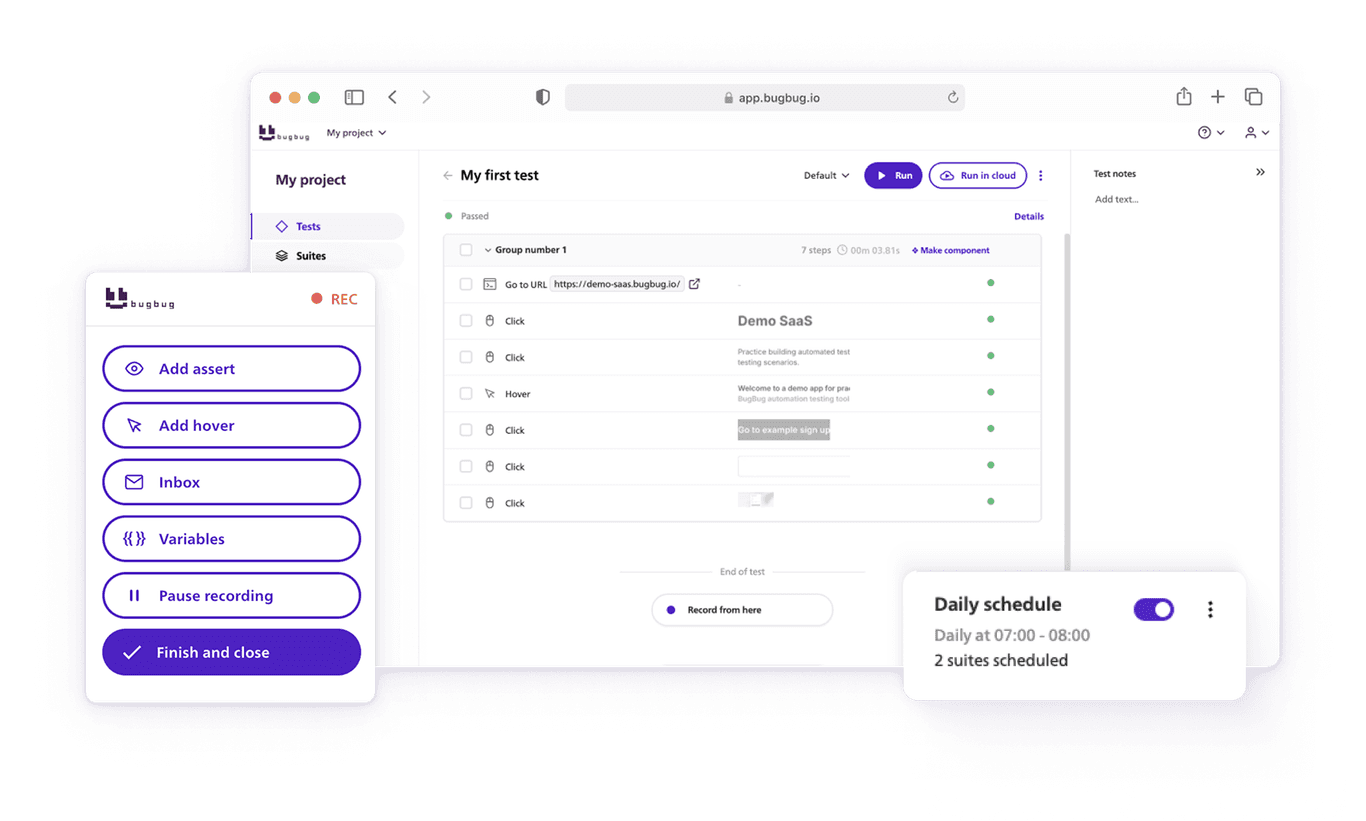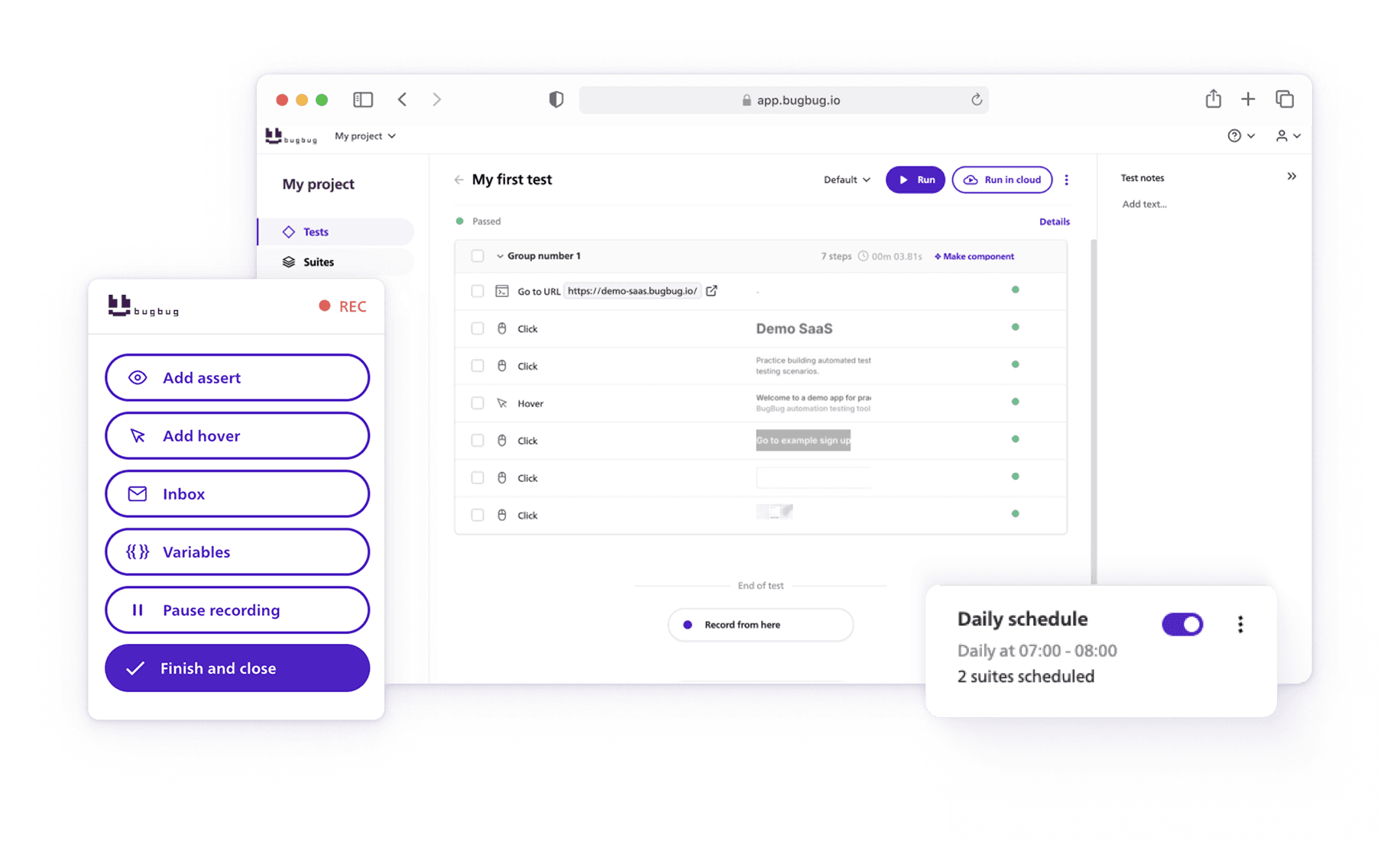🤖 Summarize this article with AI:
💬 ChatGPT 🔍 Perplexity 💥 Claude 🐦 Grok 🔮 Google AI Mode
Even the fastest systems can fail silently under continuous use.
A web app might handle peak traffic flawlessly for an hour — only to slow down or crash after running overnight.
That’s where soak testing comes in.
- 🎯 TL;DR - What Is Soak Testing?
- Why Soak Testing Deserves a Place in Every QA Strategy
- What Is Soak Testing (Definition and Core Concept)
- When Should You Conduct Soak Testing?
- Common Problems Uncovered by Soak Tests
- How to Design a Soak Test (Step-by-Step Guide)
- Key Components of a Reliable Soak Test Setup
- Analyzing Soak Test Results
- Benefits of Soak Testing
- Common Challenges (and Practical Solutions)
- How BugBug Supports Continuous and Long-Running Tests
- Conclusion: Build Confidence in Your System’s Endurance
- FAQ - Soak Testing
🎯 TL;DR - What Is Soak Testing?
- Soak testing measures how your system performs and behaves under sustained, realistic load over long periods — often 12 to 72 hours.
- It detects slow, cumulative issues such as memory leaks, thread exhaustion, or resource bottlenecks that short tests miss.
- Soak tests should be conducted before major releases, infrastructure changes, or high-traffic events, and ideally integrated into your CI/CD pipeline.
- Effective soak testing requires production-like environments, realistic user flows, and continuous monitoring of metrics like CPU, memory, and response times.
- Tools like JMeter, k6, and BugBug help automate and schedule endurance scenarios — combining backend load testing with long-term UI and regression checks.
Check also:
Why Soak Testing Deserves a Place in Every QA Strategy
Soak testing is a performance testing method designed to measure how a system behaves under a sustained load over time.
Instead of focusing on short bursts or breaking points, it reveals slow, hidden degradations — the kind that cause memory leaks, creeping latency, or gradual slowdowns in production.
For teams building SaaS platforms, e-commerce systems, financial apps, or cloud services, these long-term issues can quietly erode reliability.
A product that runs fine for an hour might start timing out after 12 hours if memory isn’t released properly or database connections pile up.
That’s why soak testing deserves a dedicated place in every QA and DevOps strategy.
It ensures that performance remains stable not just at launch — but every hour your product is live.
And when combined with continuous testing tools and automation frameworks, soak testing becomes a cornerstone of production-grade reliability.
What Is Soak Testing (Definition and Core Concept)
Soak testing is a type of software testing that measures system stability and performance under a continuous load for an extended period of time.
Unlike stress testing or spike testing, which push systems to their limits under extreme load, soak tests focus on sustained, realistic traffic that mimics actual production use.
During a soak test, the test environment simulates expected load — users logging in, performing transactions, or retrieving data — for hours or even days. This helps the development team evaluate how the system’s performance, memory usage, and resource management behave over time.
What Is The Goal of Soak Testing?
The goal is early detection of hidden performance issues such as memory leaks, garbage collection inefficiencies, or database connection leaks that don’t appear during short-term testing.
Because soak testing detects these problems gradually, it provides more accurate results for capacity planning and ensures continuous availability in a production environment.
Soak tests run over an extended duration using cloud resources or on-prem infrastructure, depending on the system’s complexity. They are typically performed after functional testing, before release, or as part of continuous testing to validate system behavior and system’s ability to maintain performance during continuous usage.
In short, soak testing verifies that your software can maintain performance and resource utilization across a long period of time — ensuring system’s availability and reliability during actual production use.
Soak vs. Endurance Testing
These two are often used interchangeably, but there’s a subtle distinction:
- Endurance testing checks how performance changes over time.
- Soak testing digs deeper into stability and resource utilization during that time.
It’s a long-term health check for your system — ensuring the app stays performant and predictable even after running continuously.
Popular Soak Testing Tools
- Apache JMeter – versatile and widely used for APIs and web apps.
- k6 – lightweight, developer-friendly, and CI/CD ready.
- Gatling – built for high-traffic simulations.
- Locust – Python-based and highly customizable.
These tools can simulate long-duration workloads and record metrics such as response times, throughput, and resource usage — helping testers visualize degradation patterns before they hit production.
When Should You Conduct Soak Testing?
The short answer: before problems appear in production.
Soak testing should be part of your regular performance testing strategy, especially at critical milestones:
Before a Major Release
Validate that recent changes won’t cause slowdowns or leaks after prolonged usage. Think of it as a “burn-in test” for your release candidate.
After Infrastructure or Architectural Changes
Server migrations, database engine upgrades, or moving to new cloud providers can all impact how a system behaves over time. Soak tests confirm long-term stability under the new setup.
Before Anticipated High-Traffic Events
Before sales, campaigns, or app launches, soak testing ensures your system performs consistently under sustained demand — not just sudden spikes.
As Part of Continuous Performance Testing
Integrate soak testing into your CI/CD pipeline to catch slow degradations early.
Automated soak tests can run nightly or weekly, building historical performance baselines.
During Off-Peak Hours
Run soak tests when production traffic is low to gather data without user disruption, especially in staging environments that mirror production.
Rule of thumb: Run soak tests whenever stability, uptime, or sustained performance truly matter.
Common Problems Uncovered by Soak Tests
Soak tests reveal gradual, cumulative issues that short tests miss — the ones that quietly drain resources over time.
Memory Leaks
When code fails to release memory properly, usage slowly increases until the system slows down or crashes.
A 14-hour test might show doubling response times due to a small caching leak invisible in shorter sessions.
Database Resource Leaks
Unclosed connections or statements gradually exhaust database pools. Symptoms include slow queries, timeouts, or unresponsiveness.
Thread or Handle Exhaustion
Applications that don’t release threads or file handles correctly hit OS limits over time. You’ll notice CPU spikes or slower response rates after several hours.
Performance Degradation
Even healthy systems degrade as caches fill or logs grow. Soak tests visualize this drift, showing whether performance stays consistent over hours or days.
System Recovery Failures
After the test ends, the system should reset gracefully. Soak testing’s cooldown phase ensures resources are freed and services return to baseline without manual restarts.
In short: Soak testing catches the “slow killers” — leaks, drifts, and degradations that quietly threaten uptime.
How to Design a Soak Test (Step-by-Step Guide)
To run an effective soak test, follow a structured plan:
- Define Objectives – What risks are you testing for (stability, leaks, resource limits)?
- Identify Key Metrics – Track response time, error rate, CPU, memory, and throughput.
- Create Realistic Scenarios – Simulate real user flows with authentic data and pacing.
- Set Up a Production-Like Environment – Match configurations, data volumes, and dependencies.
- Implement Monitoring Tools – Use Prometheus, Grafana, Datadog, or ELK for visibility.
- Determine Duration – Run long enough to expose slow degradation (12–72 hours typical).
- Execute and Monitor Continuously – Automate checks, alerts, and threshold warnings.
- Analyze Results – Compare early vs. late performance trends.
- Report, Fix, and Re-Test – Optimize based on findings and verify improvements.
Pro tip: Automate soak tests in CI/CD pipelines for repeatable performance baselines.
Key Components of a Reliable Soak Test Setup
To ensure credible results, get these elements right:
- Production-Like Environment: Mirror hardware, configurations, and dependencies.
- Realistic Workloads: Base simulations on real analytics and user patterns.
- Continuous Monitoring: Track CPU, memory, and error metrics in real time.
- Data Management: Refresh datasets to prevent skewed caching.
- Defined Stability Criteria: Establish acceptable thresholds for degradation and error rate.
- Recovery Validation: Confirm systems reset correctly after the test.
Realism, visibility, and repeatability — the three pillars of a trustworthy soak test.
Analyzing Soak Test Results
Soak tests generate hours (or days) of data — but the insight lies in trends, not numbers.
- Compare Start vs. End State: Look for drift in response times or resource usage.
- Identify Performance Drift: Rising memory or CPU usage over time signals inefficiencies.
- Correlate Metrics: Align spikes in latency with system metrics to pinpoint causes.
- Watch for Threshold Crossings: Note how often resource limits are breached.
- Evaluate Recovery: After the test, ensure systems return to baseline automatically.
- Visualize Findings: Use dashboards to highlight trends and anomalies for faster fixes.
Insight over data: The power of soak testing lies in spotting gradual decay before users feel it.
Benefits of Soak Testing
Soak testing’s impact goes beyond performance — it strengthens reliability, scalability, and user trust.
- Reveals long-term issues invisible in short tests.
- Detects leaks early, preventing production outages.
- Validates resource usage for cost-efficient scaling.
- Improves user experience by ensuring stable responsiveness.
- Verifies continuous uptime for always-on systems.
- Reduces risk of regressions and downtime in CI/CD cycles.
- Builds performance baselines for ongoing optimization.
Common Challenges (and Practical Solutions)
| Challenge | Solution |
|---|---|
| Resource constraints | Use cloud-based environments or lightweight tools like BugBug to scale efficiently. |
| Long test durations | Automate scheduling and alerts; integrate tests into CI/CD. |
| Data management | Rotate and randomize datasets to prevent unrealistic caching. |
| Issue isolation | Correlate logs, metrics, and traces for faster root cause analysis. |
| Result interpretation | Automate trend visualization and focus on delta comparisons. |
| Maintaining test scripts | Use maintainable frameworks; BugBug enables visual, low-maintenance UI test automation. |
How BugBug Supports Continuous and Long-Running Tests
While BugBug specializes in automated UI and end-to-end testing, its scheduling and parallel execution features make it ideal for long-duration test cycles.
You can use BugBug to:
- Run repetitive test scenarios over extended periods.
- Automate browser-level regression tests overnight or post-deployment.
- Validate UI stability as part of a larger performance strategy.
When paired with performance tools like JMeter or k6, BugBug completes the testing pipeline — helping teams ensure both frontend stability and backend endurance with minimal manual effort.
Conclusion: Build Confidence in Your System’s Endurance
In modern software development, soak testing complements load testing and other performance tests by focusing on how a system behaves during a continuous availability period.
It helps teams verify that the operating system, application, and infrastructure can mimic real-world usage without suffering from memory allocation issues, resource exhaustion, or other resource leaks.
Although it can be a time-consuming process requiring technical expertise, its key benefits include uncovering long-term degradation and improving reliability in a live environment.
By continuously tracking performance metrics such as memory consumption, response time, and throughput, soak testing ensures that systems maintain stability under significant load.
In the end, effective soak testing proves that your product can handle real world usage gracefully — closing database connections properly, managing resources efficiently, and sustaining performance far beyond short-term tests.
Your system doesn’t just need to run fast — it needs to run forever.



